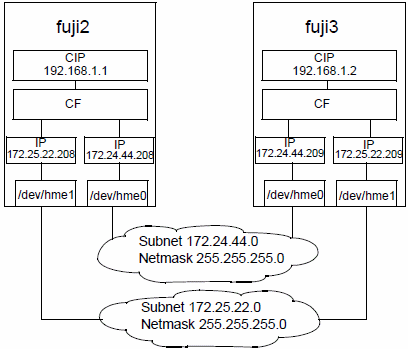Although the two terms CF over IP and CIP (also known as IP over CF) sound similar, they are two very distinct technologies.
CIP defines a reliable IP interface for applications on top of the cluster foundation (CF). CIP itself distributes the traffic generated by the application over the configured cluster interconnects (see Figure below).
Figure 1.1 CIP diagram

CF over IP uses an IPv4 interface, provided by the operating system, as a CF interconnect. This is not operated on IPv6. The IP interface should not run over the public network. It should only be on a private network, which is also the local network. The IP interface over the private interconnect can be configured by using an IP address designed for the private network. The IP address normally uses the following address:
192.168.0.xx is an integer between 1 and 254.
During the cluster joining process, CF sends broadcast messages to other nodes; therefore, all the nodes must be on the same local network. If one of the nodes is on a different network or subnet, the broadcast will not be received by that node. Therefore, the node will fail to join the cluster.
The following are possible scenarios for CF over IP:
Where the cluster spans over two Ethernet segments of the same sub network.
Each sub-level Ethernet protocol is not forwarded across the router but does pass IP traffic.
When you need to reach beyond the physical cable length.
Regular Ethernet is limited to the maximum physical length of the cable. Distances that are longer than the maximum cable length cannot be reached.
If some of the network device cards that only support TCP/IP (for example, some Fiber channel) are not integrated into CF.
Note
Use CF with the Ethernet link-level connection whenever possible because CF over IP implies additional network/protocol information and usually will not perform as well (see Figure below).
Figure 1.2 CF over IP diagram

CF over IP is not supported in a Solaris 11 or later environment.